Trending
Opinion: How will Project 2025 impact game developers?
The Heritage Foundation's manifesto for the possible next administration could do great harm to many, including large portions of the game development community.
By name alone, Mr. Do! sounds more like Silly Game than Great Game. It is, in fact, a silly game, but make no mistake, Mr. Do! is also one of the most underappreciated classic arcade games of all time.

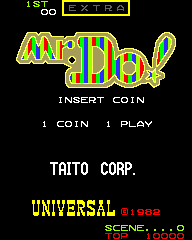
Mr. Do! Arcade Title Screen
By name alone, Mr. Do! sounds more like Silly Game than Great Game. It is, in fact, a silly game, but make no mistake, Mr. Do! is also one of the most underappreciated classic arcade games of all time. It deserves a historical place right along side some of the greatest of the era, while at the same time earning a hallowed place all its own. Pac-Man, Space Invaders, Frogger, Donkey Kong, Galaga, Robotron 2084, Pole Position, Dig Dug, Mr. Do! (The exclamation point is actually in the title, so when making a list you always have to end with it.)
I first encountered Mr. Do! while attending St. Ambrose Catholic School which even today is still firmly entrenched in the working class neighborhood of South Buffalo in Buffalo, New York, where I grew up. There was a game room attached to the gymnasium that the school’s Boys Club had access to every other Friday night. Inside was a pool table, pinball, air hockey and shuffleboard, among other games I can’t remember, and three arcade cabinets: Atari Football (the one with the Xs and Os), Frogger and Mr. Do! (Again, you have to end with it.)
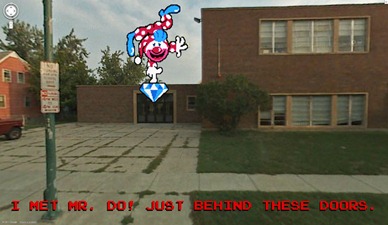
Gym Entrance to the Game Room.
Once you reached the 6th grade at St. Ambrose, you could attend Boys Club events, which included an occasional Buffalo Sabres game at the Aud with the dads and father-son breakfasts with a Sabres or Buffalo Bills player. But during the regular meetings every other Friday night, it was mostly a choice between playing dodgeball or hockey, making something in the art room, or hanging out in the game room listening to ’80s metal. Once I discovered Mr. Do!, I began spending more time in the game room and less time running like hell from the 8th graders in dodgeball.
Not to say that discovering Mr. Do! saved my life or anything, but the 8th graders used to throw bombs in dodgeball. (The school’s fire alarm was once set off when one such bomb went astray and smashed the glass on the wall switch.) Mr. Do! did, however, hook me to the point where I would be wide awake in bed thinking of new Do!strategies after a night of playing the shit out of it at Boys Club. I’ve been nerdy about Mr. Do! ever since.

Mr. Do! gameplay, first stage
One quick way to get on my bad side is to ask if I’m playing Dig Dugwhile I’m playing Mr. Do! It never ceases to amaze me.
“Oh, is this Dig Dug?”
No, it ain’t Dig Dug. It’s Mr. Do! you moron. How could you even confuse the two?
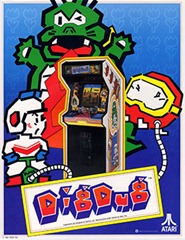
Dig Dug Arcade Promo
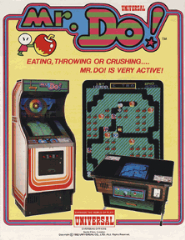
Mr. Do! Arcade Promo
Not that I don’t like Dig Dug. I’ve always thought it was a fun game. But when dummies like The Video Game Critic dismiss Mr. Do! as a “fast-moving Dig Dug clone,” it’s clear that Mr. Do! isn’t getting the props it deserves. Pure Mr. Do! ignorance.
Yes, of course there are similarities, but to me -- even at first glance –- the games look nothing alike. To most apparently, the games look exactly alike, which I find baffling. I think this is the primary reason Mr. Do! isn’t often mentioned among the truly classic arcade games of the early '80s. The mighty Dig Dug casts such a huge shadow of nostalgia from which Mr. Do! can’t seem to escape, even though both games were released in the same year (1982).
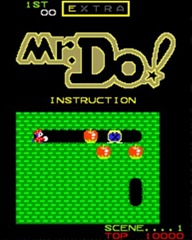
Mr. Do! Instruction Screen
Whereas Dig Dug put you in control of a spaceman with an air pump, in Mr. Do! you’re a cherry-picking clown wielding a bouncy ball of death. It’s truly a nightmarish scenario: You dig mazes through endless waves of colorful cherry fields –- running like hell from a horde of freaky Sesame Street and Muppets rejects who happily and ferociously chase you all around the screen. Unleashing the ball at the right time can often save you when you’re cornered, but the ball is also unpredictable in its movement and only one can be thrown at a time, which often leaves you defenseless, and dead.
No matter. Mr. Do! can also set booby traps by not only burrowing underneath giant apples (which causes them to fall), but also bypushing the giant apples off ledges and onto unsuspecting monsters. That’s why they call him Mr. Do! He can do things.

Mr. Do! Cabinet Side Art
The bad guys can also do things however. There are crazy killer red hemorrhoid monsters who can not only push the big apples around like you can, but can also morph into beast mode and maul your silly clown ass. Grabbing the revealed bonus treat at the center of each level drops the bastard children of The Letter People into the fray, who proceed to haunt you down with a posse of relentless cookie monster heads seemingly high on angel dust. Seriously. They eat right through the apples, too. But if you manage to kill each letter on legs and spell the word “EXTRA,” well … “YOU GET EXTRA Mr. Do!”
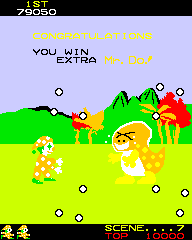
Mr.Do! Spells E-X-T-R-A
Progression through the game isn’t nearly as straightforward as in other classic maze games. Clearing a level of enemies will get you through to the next level just as in Dig Dug, but in Mr. Do!, you can also finish a level by either collecting all the cherries, completing the EXTRA puzzle or getting the secret bonus diamond, which only appears when an apple is dropped on just the right spot. Skillful managing of all of these tasks maximizes your point total, which in the end separates the men from the boys in games like this. The many ways you can earn points and clear levels injects Mr. Do! with a certain strategy in achieving high scores that simply doesn’t exist in games like Pac-Man or Dig Dug.
Overall, there’s just so much more going on in Mr. Do! compared to most other games from the early ’80s. Few games feature the same combination of chaotic action, whimsical visuals and depth of gameplay.
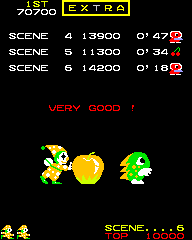
Mr. Do! Intermission
Sure, the primitive sounds and music will drive any normal person insane after a short while (especially the obnoxious sound of that bouncing ball), and the intermission screens that tell you “GOOD JOB!” and “CONGRATULATIONS … YOU WIN EXTRA Mr. Do!” contain laughably bad graphics and animation, but to me it all only makes Mr. Do! more awesome. In general, videogame graphics and sound were still very much at the amateur level back then. It wouldn’t be until the end of the decade when games began to really mature visually, so for me, Mr. Do! represents that time when games had to hook you at the gameplay level and get just enough out of the graphics to serve the action.
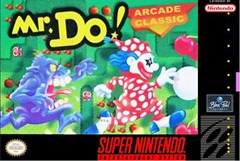
Mr. Do! Super NES Box
I currently get my Mr. Do! fix by playing the excellent Super NES version released by Imagineer and Black Pearl Software in 1995. I found it for $5 at a video rental store in Evansville, Indiana many years ago. While the Nintendo controller is a poor substitute for the original arcade joystick, it’s the next best thing to having a real Mr. Do! arcade cabinet. Even better, a competitive two-player versus mode was added which is actually pretty fun. Other versions of Mr. Do! were released for the Atari 2600, ColecoVision and Nintendo Game Boy, as well as a tricked-out 1996 sequel called Neo Mr. Do! for the Neo Geo console, but so far I’ve found the Super NES version the closest to the arcade original.
Spin-off titles featuring the Mr. Do! character include Mr. Do!’s Castle, Mr. Do!’s Wild Ride and Do! Run Run –- all completely different games from the original and nowhere near as fun.
Read more about:
BlogsYou May Also Like